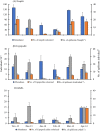Protistan epibionts affect prey selectivity patterns and vulnerability to predation in a cyclopoid copepod
- PMID: 36587046
- PMCID: PMC9805443
- DOI: 10.1038/s41598-022-26004-5
Protistan epibionts affect prey selectivity patterns and vulnerability to predation in a cyclopoid copepod
Abstract
Colonisation of crustacean zooplankton with ciliate epibionts is widespread in freshwater and marine environments. However, the ecology of such association are little studied as yet. The occurrence of ciliate epibionts on copepods and the preference towards this association with different life stages of Mesocyclops were studied from winter to spring. Relative susceptibility of zooplankton species was evaluated by analysing the epibiont colonies and zooids and relate this to the surface area of the host. The maximum epibiont infestation per unit body surface area was recorded on copepodites followed by copepod nauplii rather than other zooplankton species, whereas the rotifer Asplanchna was never affected. Influence of climatic factors such as temperature on the colonisation of epibionts on basibionts was found significant. In winter (November to February) samples, copepods were infested by autotrophic epibionts whereas in late spring and early summer (March-April) heterotrophic protists (peritrichian ciliates) were the sole epibionts on copepods. We conducted experiments in the laboratory on prey selection pattern of predators by direct visual and video-graphic observations of various events (encounter, attack, capture, ingestion, prey escape) during predation by infested and uninfested copepodites and adults of Mesocyclops. Postencounter the attack probability was significantly lower in infested than in uninfested copepods. The present paper reports on substrate preference by epibionts and their impacts in food rich and food scarce environments. Furthermore, major environmental interactions were studied with the reproductive phenology of copepods with respect to epibionts and the cause and effect of long term association of epibionts with copepods need to be addressed.
© 2022. The Author(s).
Conflict of interest statement
The authors declare no competing interests.
Figures






Similar articles
-
Spatial and temporal patterns in the occurrence of peritrich ciliates as epibionts on calanoid copepods in the Chesapeake Bay, USA.J Eukaryot Microbiol. 2005 May-Jun;52(3):236-44. doi: 10.1111/j.1550-7408.2005.00025.x. J Eukaryot Microbiol. 2005. PMID: 15927000
-
Combined effects of copper and temperature on the functional response of native (Mesocyclops longisetus and Microcyclops dubitabilis) and invasive (Mesocyclops pehpeiensis) copepods fed rotifers and cladocerans.Sci Total Environ. 2025 Apr 25;974:179179. doi: 10.1016/j.scitotenv.2025.179179. Epub 2025 Mar 25. Sci Total Environ. 2025. PMID: 40138894
-
Ciliate epibionts associated with crustacean zooplankton in german lakes: distribution, motility, and bacterivory.Front Microbiol. 2012 Jul 5;3:243. doi: 10.3389/fmicb.2012.00243. eCollection 2012. Front Microbiol. 2012. PMID: 22783247 Free PMC article.
-
Predation effect on copepods by the giant jellyfish Nemopilema nomurai during the early occurrence stage in May in the northern East China Sea and southern Yellow Sea, China.Mar Pollut Bull. 2023 Jan;186:114462. doi: 10.1016/j.marpolbul.2022.114462. Epub 2022 Dec 13. Mar Pollut Bull. 2023. PMID: 36521364 Review.
-
A synthesis of growth rates in marine epipelagic invertebrate zooplankton.Adv Mar Biol. 2003;44:1-142. doi: 10.1016/s0065-2881(03)44002-9. Adv Mar Biol. 2003. PMID: 12846041 Review.
Cited by
-
Escape performance in the cyclopoid copepod Oithona davisae.Sci Rep. 2024 Jan 11;14(1):1078. doi: 10.1038/s41598-024-51288-0. Sci Rep. 2024. PMID: 38212397 Free PMC article.
-
In silico and network pharmacology analysis of fucosterol: a potent anticancer bioactive compound against HCC.Med Oncol. 2024 Apr 27;41(6):130. doi: 10.1007/s12032-024-02374-w. Med Oncol. 2024. PMID: 38676780
-
Identification of superior haplotypes for flowering time in pigeonpea through candidate gene-based association study of a diverse minicore collection.Plant Cell Rep. 2024 May 31;43(6):156. doi: 10.1007/s00299-024-03230-x. Plant Cell Rep. 2024. PMID: 38819495
References
-
- Wahl M, Hay ME, Enderlein P. Effects of epibiosis on consumer–prey interactions. Hydrobiologia. 1997;355:49–59. doi: 10.1023/A:1003054802699. - DOI
-
- Fernandez-Leborans G, Zitzler K, Gabilondo R. Protozoan ciliate epibionts on the freshwater shrimp Caridina (Crustacea, Decapoda, Atyidae) from the Malili lake system on Sulawesi (Indonesia) J. Nat. Hist. 2006;40:1983–2000. doi: 10.1080/00222930601010861. - DOI
-
- Puckett GL, Carman KR. Ciliate epibiont effects on feeding, energy reserves, and sensitivity to hydrocarbon contaminants in an estuarine harpactacoid copepod. Estuaries. 2002;25:372–381. doi: 10.1007/BF02695980. - DOI
-
- Fernandez-Leborans G. Epibiosis in Crustacea: an overview. Crustaceana. 2010;83:549–640. doi: 10.1163/001121610X491059. - DOI
-
- Regali-Seleghim MH, Godinho MJ. Peritrich epibiont protozoans in the zooplankton of a subtropical shallow aquatic ecosystem (Monjolinho Reservoir, São Carlos, Brazil) J Plankton Res. 2004;26:501–508. doi: 10.1093/plankt/fbh055. - DOI
Publication types
MeSH terms
LinkOut - more resources
Full Text Sources
Miscellaneous

